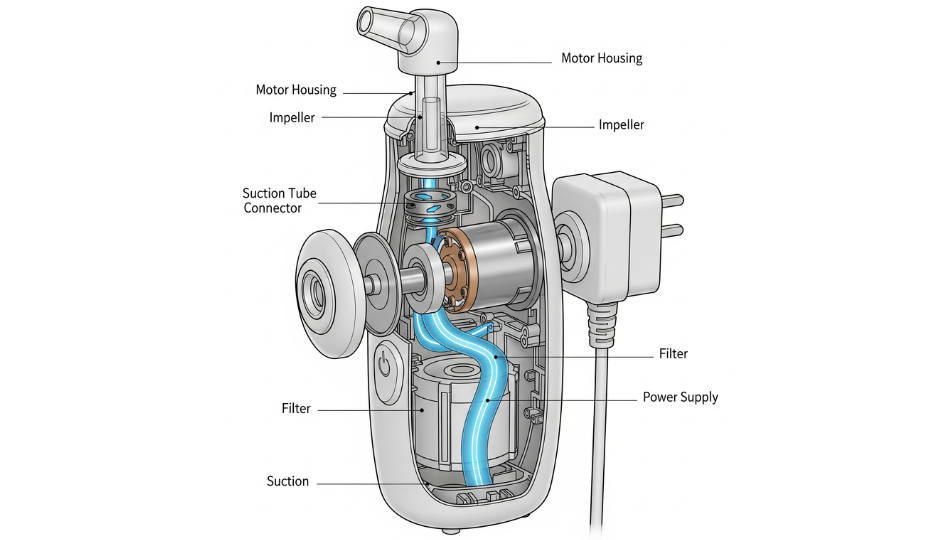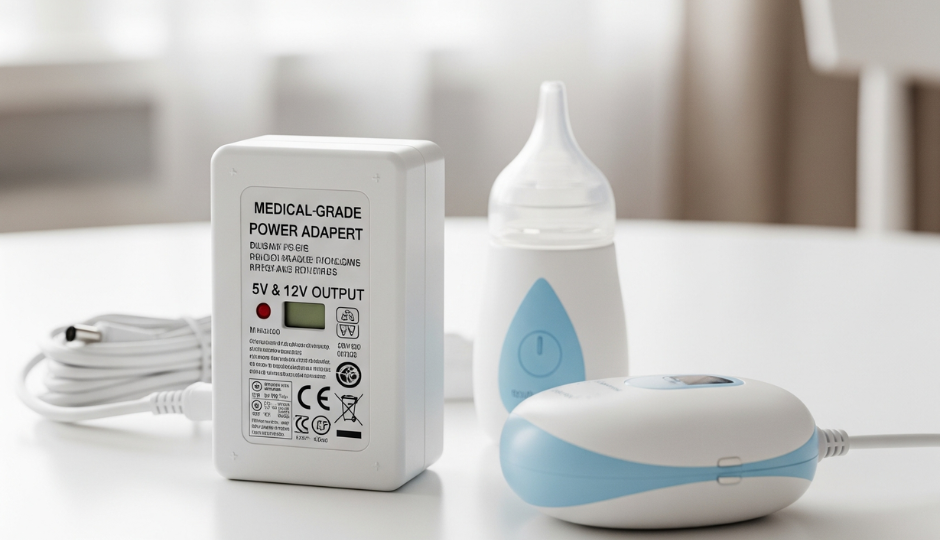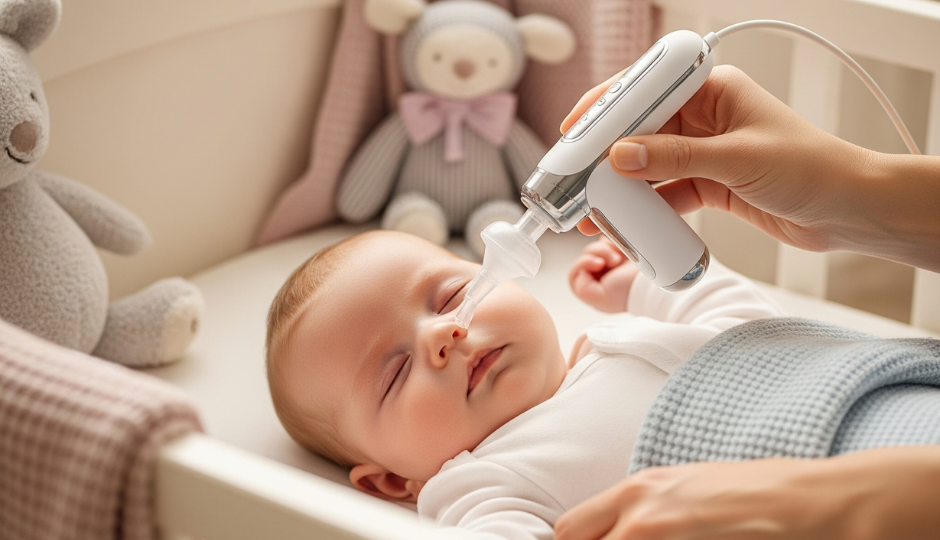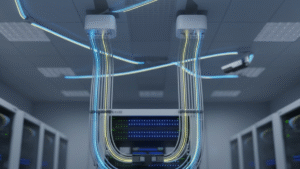When a baby can’t breathe because of nasal congestion, parents often turn to a nasal aspirator for quick relief. But what happens when the device fails right at that moment? From my experience, it’s often not the fault of the aspirator, but the power adapter. A power adapter that isn’t optimized for the device can reduce suction, introduce noise, or even lead to permanent damage. The right adapter isn’t a minor detail. It’s critical.
Nasal aspirators require regulated power with medical-grade reliability. Inconsistent voltage or poor filtering from generic power adapters can lead to safety issues, failed operation, and discomfort during use.
The Role of Power in Nasal Aspirator Performance
As a product developer, I’ve seen power adapters treated as an afterthought in consumer electronics. But with nasal aspirators, this can be a costly mistake. These devices must operate quietly, reliably, and safely, especially for infants. Most aspirators are powered by low-voltage adapters—typically 5V, 9V, or 12V—with current ratings up to 2A, depending on the suction strength. If the adapter can’t deliver clean, stable power, the motor doesn’t run consistently. Suction drops, noise increases, and the user experience deteriorates.

What Are the Power Requirements for Nasal Aspirators?
Most nasal aspirators seem simple on the surface. But internally, they rely on precision components—brushless motors, microcontrollers, and sometimes even heating elements. These parts demand consistent, clean DC power.
Nasal aspirators typically require 5–12V DC, 0.5–2.0A, with ripple noise under 150mVp-p, and certification to meet safety regulations like UL, CE, FCC, and DOE VI.
Dive Deeper: Technical Breakdown
| Specification | Ideal Value | Purpose |
|---|---|---|
| Voltage Output | 5V / 9V / 12V | Matches motor and control board requirements |
| Current Output | 0.5A to 2.0A | Ensures motor torque and air pressure |
| Ripple Noise | Under 150mVp-p | Prevents audible buzzing and circuit instability |
| Short-Circuit Protection | Required | Prevents failure if the aspirator is blocked |
| Safety Certifications | UL, CE, FCC, RoHS | Allows legal sale and ensures end-user safety |
| Energy Efficiency | DOE Level VI or better | Reduces heat, saves energy, and prolongs adapter life |
The ripple factor is particularly critical. I’ve seen aspirators with cheap adapters produce irritating whines due to excessive ripple. This not only upsets the baby but also stresses the internal electronics.

Why Adapter Noise Matters in Baby Care Products
Baby care electronics, including nasal aspirators, demand extra attention to noise. Parents often use these devices during sleep or when the baby is already irritated.
Poorly filtered power supplies can inject high-frequency noise into motors, creating vibration and noise that reduces comfort and increases the chance of device rejection.
Dive Deeper: The Science of EMI and Ripple
Cheap power adapters often cut corners on EMI filters. They use basic transformers and limited filtering capacitors. As a result, high-frequency noise generated during AC-DC conversion travels into the output. In nasal aspirators, this leads to:
- Unstable RPM in the motor
- Pulsating or weak suction
- High-pitched whines or buzzing
- Reduced lifespan due to thermal stress
If you target international markets, noise standards become non-negotiable. For example, EN55032 sets limits for conducted and radiated EMI. Without compliance, your product may be banned from sale or face high return rates.

Can You Use Universal Adapters for Nasal Aspirators?
Using a generic adapter might save initial cost. But it risks long-term reliability and user trust.
Universal power supplies often lack voltage regulation, noise filtering, and proper protections, making them unsuitable for medical or baby-focused products.
Dive Deeper: Dangers of Poor Adapter Matching
I’ve worked with clients who bundled standard USB chargers with their nasal aspirators. During testing, units failed after just 90 minutes of use. Why? The adapters entered thermal shutdown due to insufficient current output. Others caused the device to pulse unpredictably because the voltage dropped under motor load.
Comparison:
| Feature | Generic Adapter | Quankang Medical Adapter |
|---|---|---|
| Voltage Regulation | ±10% | ±3% |
| Short-Circuit Protection | Optional | Standard |
| EMI Filtering | Minimal | Multi-stage |
| Certifications (UL/CE/FCC) | Often missing | Complete |
| Output Ripple | >300mVp-p | <150mVp-p |
| Medical Use Approval | None | IEC 60601 ready |
You can’t expect professional performance from consumer-grade components. For baby products, reputational risk is too high to cut corners.
How to Choose the Right Adapter Supplier for Nasal Aspirators
Your device is only as reliable as its weakest component. And in many nasal aspirators, the weakest link is often the adapter.
Choose suppliers who understand medical applications, provide custom specifications, and have proven certifications for global sales.
Dive Deeper: Questions to Ask Before You Buy
When evaluating adapter manufacturers, I always ask:
- Do they have experience in baby or healthcare electronics?
- Can they customize voltage, current, label, cable length, and plug type?
- Can they deliver samples fast (under 7 working days)?
- Do they test 100% of units under full load before shipping?
- Can they provide full documentation (UL report, EMC test report, CB, DoC)?
- Do they comply with DOE VI or CoC Tier 2 efficiency standards?
Working with a partner like Quankang gives you more than a power source—it gives you peace of mind. We provide:
- Medical-grade adapters from 5W to 60W
- Customized connectors and cables
- Certifications for North America, Europe, and Asia
- Reliable, low-ripple, high-efficiency designs
- Fast response and engineering support
Conclusion
Power adapters directly affect how well a nasal aspirator functions. When quality, safety, and comfort matter, don’t compromise on power.




